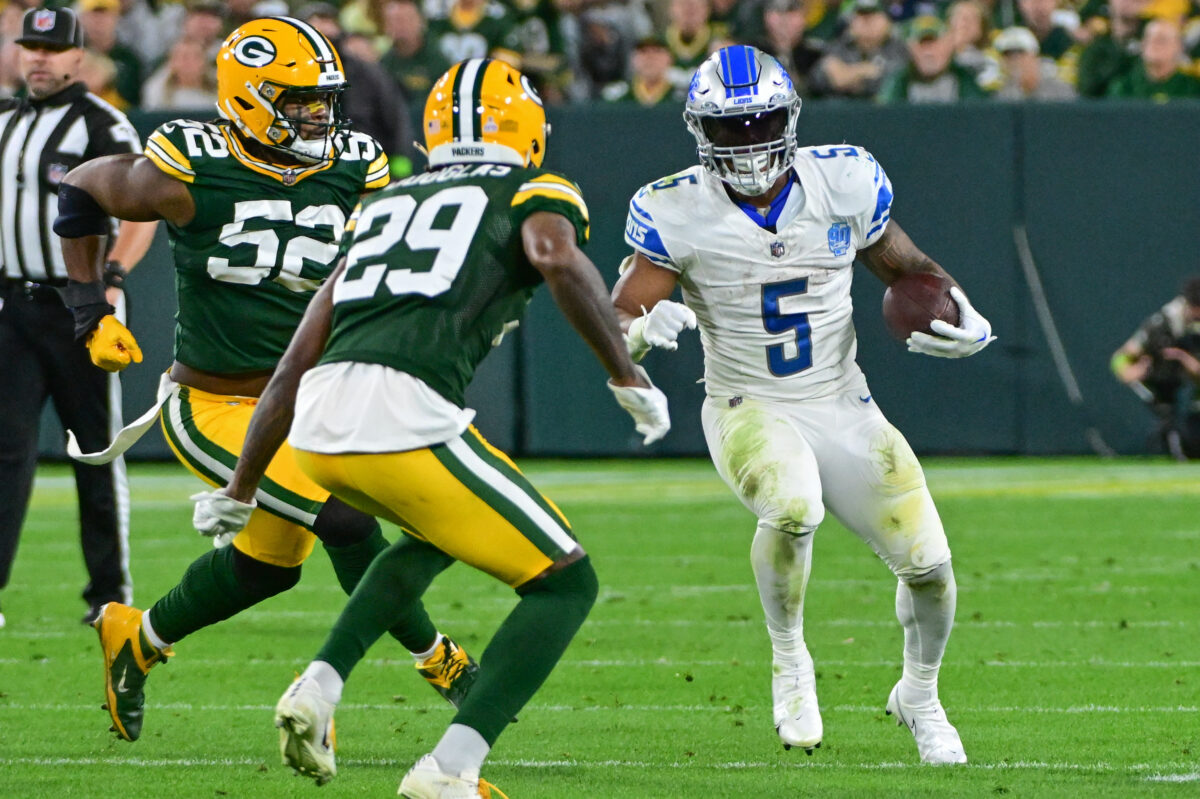Outside of a few drives in the third quarter, the Detroit Lions dominated the Green Bay Packers from start to finish in Thursday night’s game, and doing so began with the Lions controlling the trenches on both sides of the ball.
“Give Detroit a lot of credit, they whooped us pretty good,” said Matt LaFleur postgame.
For the second time in four games, the Packers defense allowed an opponent to rush for over 200 yards. Detroit totaled 211 rushing yards at 4.9 yards per rush. Rookie Jahmyr Gibbs averaged 5.0 yards per rush on his eight attempts, while David Montgomery totaled 121 yards on his own.
The Packers need change when it comes to stopping the run.
“We are going to have to do something different because it’s insane to do the same things over and over again and expect different results,” said LaFleur. “That is a good offensive line. They got really good runners. I think Gibbs and Montgomery are two of the better backs.
“That’s one of the best offensive lines in ball,” LaFleur added, “but it’s still inexcusable. We should be able to take one phase away from them. If you want to stop the run then commit to that and make them throw it over your head.”
The Lions want to run the ball. They entered Thursday’s game averaging the seventh-most rush attempts per game. This then sets up play-action opportunities for them, where Jared Goff has been very efficient and, in general, opportunities in the passing game.
By staying ahead of the sticks more often than not, it also took some of the bite away from the Green Bay pass rush—the strength of this unit. Goff was able to lean on the quick passing game, making it difficult for the pass rushers to get home, and when a defense is consistently in short down and distance situations, the front can’t be as aggressive from a pass rush standpoint because they have to worry about the run as well.
On the other side of the ball, as had been the case through the first three games of the season, the Packers couldn’t find any success on the ground. They finished the game averaging only 2.3 yards per carry as a team.
“We were three and out five possessions in a row, or whatever it was,” said LaFleur. “That was very humbling. Sometimes that happens but we can’t continue to go backwards. We keep going backwards and we are in third and long situations.
“We knew they were going to be a challenge to run the football against. They’ve done a nice job with that. We had some run-pass options, some canned plays, and give credit to them, they did a good job because when we threw it, we weren’t ver effective throwing the football either.”
The Lions defense has been one of the best in football this season. They entered Thursday’s contest allowing just 3.2 yards per carry and bottled up Atlanta’s Bijan Robinson just this past Sunday. This factor, coupled with Detroit dealing with injuries in the secondary, the Packers came out throwing the ball, beginning the game with six straight passes.
However, a Packers offensive line unit that had been so good in pass protection this season, crumbled from the first snap of the game against the Detroit defensive front. Jordan Love ended up under nearly constant duress and was sacked five times and hit 11 times. That doesn’t even include the times he was able to escape.
While the thought process behind the Packers’ early approach on offense makes sense, being one-dimensional against an Aidan Hutchinson-led defensive front is only going to end poorly.
It was clear as day against the Lions, but the Packers lack of success on early downs throughout the season has made moving the ball consistently a challenge for them. When they get behind the sticks, it just about spells doom for this offense. This then puts them in predictable passing situations, creating favorable matchups for the defense and an opportunity for the pass rush to pin its ears back. That can be difficult to overcome for any offense, let alone a young one like Green Bay has.
“They got a good D-line and we just didn’t do good enough,” said Love. “It takes all 11, it’s not just the O-line. It’s me not being able to get the ball out quick enough on some plays when the reads are open. It goes back to not executing. But it’s definitely not just on the O-line, it takes all the 11. It’s all offensively as a whole. We just got to do better.”
Improved play from this Packers team as a whole starts with the run game—on both sides of the ball. Doing so on defense will allow the best part of that unit, the pass rush, to be aggressive and get after the quarterback. While on offense, it will open up the passing game for Love and his dynamic group of receivers. A failure to do so will lead to instances of what we saw against the Lions.
“I think anytime that you go out there and you can’t effectively run the football,” said LaFleur, “and conversely can’t stop the run, that’s a recipe for losing football and that’s what happened tonight. Give Detroit credit, and they’re a tough opponent, but they man-handled us in really every phase.”
